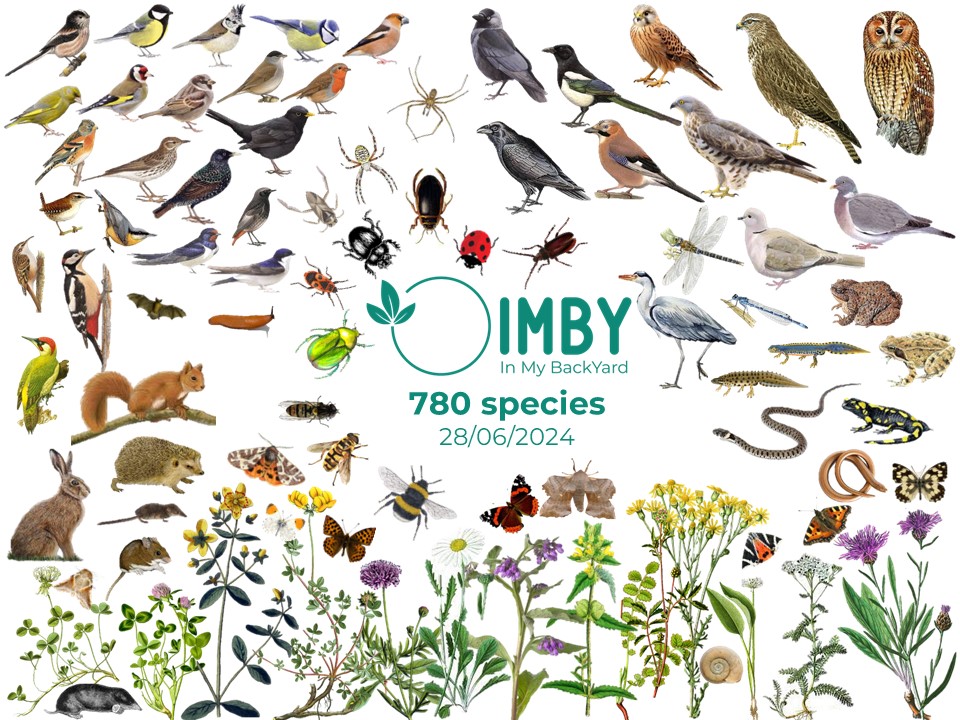Co-housing with 1,000 species!
28/06/2024
When, like us, you have the privilege of enjoying a large garden, it seems logical to share this green oasis with others. Of course, all our family, friends and neighbours are welcome, but I am more talking about a unique co-habitation with our native biodiversity. A shared garden is great and at the same time a guarantee of wonder, discovery and fascinating wandering through the seasons.

In May this year, I started observing again. It's really addictive and I am confident that the 1000-species garden is in reach. For now, the counter stands at 780 species and that's mainly thanks to the plants and moths I've been focusing on. I hope to deepen my knowledge on spiders, hoverflies, and grasshoppers this summer.
A year ago, I started diligently identifying all that beauty; plants, mushrooms and lots of critters, big and small. My ambition: a 1000-species garden, a biodiversity-friendly oasis where many species find their place. It is quite a challenge to recognize all these species but with the app obsidentify as an encyclopedia in your pocket you come a long way.
Wondering how you too can decorate your garden and welcome 1,000 species? Here are some tips:
- Avoid using chemicals - herbicides, insecticides and pesticides - as well as fertilisers in your garden. It may seem contradictory but the more nutrient-poor your meadow, the more flowers and the more insects!
- Create a multitude of mini habitats in your garden: a pond, a hedge or hedge, a forest edge, a grassland, a sandy zone, an orchard, ... After all, a garden is a human-sized mini-ecosystem. Each habitat is home to yet other species.
- Ensure to have a long diverse blooming period, a multitude of nectar and pollen bars for our pollinators, ideally from March to October. Take into account what is flowering in your grassland, but equally hedge and woodland edge. Many species specialise on certain plant families so make sure you have diversity of families too.
- Create as many gradients as possible in your garden: from dry to wet, sunny to shady, windy to sheltered. Vertical layers are also important: from grass to herb layer, to shrubs, trees and even climbers. Every little animal and plant will then find its ideal spot!
- Go for a multitude of native plants! It has been proven that the more native plant species you plant or grow in your garden, the more local animal species will arrive there.
- Invite wildlife into your garden. Every species needs food, water, shelter and a breeding place, ideally all in your garden, so they do not just pass but also stay there. A hedge is ideal for many animals, a dead hedge, a pile of stones or dead wood, a haystack, an insect hotel, nesting boxes and feeding sites in winter.
We have been applying these principles since we moved into our initially monotonous low-species garden and every year we see the species counter increasing more! The environment obviously plays an important role, if you live in the countryside surrounded by nature, biodiversity will find its way into your garden more easily. But even in the city, an ecological garden can do a lot for more common species that find it increasingly difficult. If the neighbours also join in, you can create a green network that benefits more and more species.
How do you start documenting what lives in your garden? It is simply a matter of observing throughout the seasons and at different hours of the day and night. There are a number of tools: place a moth trap, a camera trap, beat the branches of the trees with a stick and catch the insects in an umbrella, sit by the pond at early and warm hours, peer with your binoculars and recognise bird sounds with the Merlin Bird ID app, rustle in the leaves in autumn, see who visits the flowers and also look under dead wood.
In May this year, I started observing again. It's really addictive and I am confident that the 1000-species garden is in reach. For now, the counter stands at 780 species and that's mainly thanks to the plants and moths I've been focusing on. I hope to deepen my knowledge on spiders, hoverflies, and grasshoppers this summer.
Living together with biodiversity also means: voles nibbling on the roots of our fruit trees, sharing your cherries with starlings, an ant invasion in the bathroom, wintering ladybirds in the house, snails feasting in the vegetable garden, a stone marten under our roof, a nest of shrews in our compost heap, the great spotted woodpecker robbing our insect hotels and sore ants with strong jaws at garden work. But that's just part of it, these are lessons in humility and show that nature always has the last laugh after all! I would not want to miss it!
I wish you all lots of fun discovering, marveling and observing all that diversity in your garden. Be sure to save your data in Obsidentify (observations.org), this way you also contribute to citizen science. If you want some help getting started, organise a mini-bioblitz in your garde, , install a wildlife camera or test a moth trap, be sure to contact us. Find out more about the services we offer here.
Comments
- Knap An en Frank, nog 220 te gaan 😉 (Johan)
- Heel interessant en mooie website. We leren telkens bij en proberen in onze mooie maar klassieke tuin iets toe te passen.Proficiat👍 (Roos)
Add a comment


